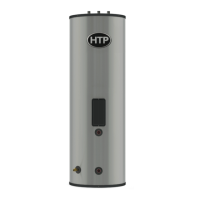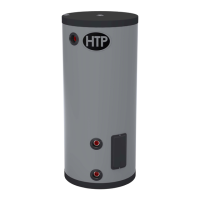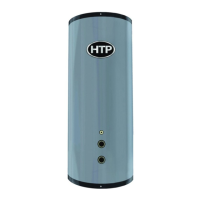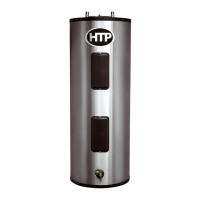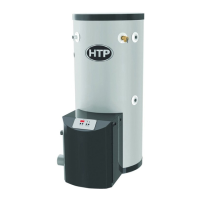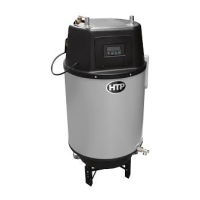lp-65 Rev. 1.6.15
6
Part 3 - Piping
A. Plumbing
It is mandatory that all plumbing be done in accordance with
federal, local, and state plumbing codes and practices. Failure
to properly install the water heater WILL VOID the warranty. It
is also necessary to use both thread tape and pipe dope on all
mechanical plumbing connections.
When lling the water heater, open a hot water tap to release
air in the tank and piping. Failure to do so could lead to improper
water heater operation and damage to components.
B. Boiler Connections
Use two wrenches when tightening water piping at the heater.
Use one wrench to prevent the heater return or supply line from
turning. Failure to prevent piping connections from turning
could cause damage to water heater components.
Use a 1” nominal minimum pipe size when piping with zone
valves or circulators.
On the water heater, the boiler supply connects to the outlet of
the circulator. The circulator inlet is to be connected to the hot
outlet side of the boiler. Be sure that the arrow on the circulator
is facing the correct ow direction. (See pressure drop sizing for
circulator, this manual.) On the tank, the boiler return connects
to the return side of the boiler. The return(s) from heating loop(s)
should have a ow check or swing check valve installed before
the return pipe from the tank.
In a steam boiler, the tank supply must be connected to the
boiiler well below the minimum water level. A strainer and drain
valve should be installed at the boiler for periodic draining of
scale and sludge. Banging and steam bound traps will occur if
the boiler water supplied to the heat exchanger has steam or is
slightly above the low water cut-o.
C. Domestic Piping Inlet
Dielectric ttings must be used on water connections.
Use both thread tape and pipe dope to connect an NPT female X
3/4” (minimum) pipe adapter. A shut-o valve between the city
water supply and tank inlet is recommended for ease of service.
It may be recommended to use a back ow preventer - check
local codes. If a back ow preventer or a no return valve is used,
a thermal expansion tank must be installed on the cold water
supply between the tank and valve. If the tank is replacing a
tankless coil in the boiler, disconnect coil plumbing and use the
cold inlet pipe and hot water outlet pipes for the water heater.
NOTE: DO NOT PLUG OUTLET IN TANKLESS COIL.
E. Temperature and Pressure Relief Valve
A factory installed temperature and pressure long element
relief valve, meeting the requirements for relief valves for water
heaters (ANSI Z21.22 / CSA 4.4) has been installed for your
safety and convenience. If servicing, make sure that the relief
valve is sized to the BTU/hour capacity and storage capacity of
the water heater. If the relief valve weeps see expansion tank
section for details.
To avoid water damage or scalding due to relief valve operation:
• Discharge line must be connected to relief valve outlet
and run to a safe place of disposal. Terminate the
discharge line in a manner that will prevent possibility of
severe burns or property damage should the relief valve
discharge.
• Discharge line must be as short as possible and the same
size as the valve discharge connection throughout its
entire length.
• Discharge line must pitch downward from the valve
and terminate at least 6” above the oor drain, making
discharge clearly visible.
• The discharge line shall terminate plain, not threaded,
with a material serviceable for temperatures of 375
o
F or
greater.
• Do not pipe discharge to any location where freezing
could occur.
• No valve may be installed between the relief valve and
heater or in the discharge line. Do not plug or place any
obstruction in the discharge line.
• Test the operation of the relief valve after lling and
pressurizing the system by lifting the lever. Make sure
the valve discharges freely. If the valve fails to operate
correctly, immediately replace with a new properly
rated relief valve.
• Test T&P valve at least once annually to ensure the
waterway is clear. If valve does not operate, turn the
heater “o” and call a plumber immediately.
• Take care whenever operating relief valve to avoid
scalding injury or property damage.
FAILURE TO COMPLY WITH THE ABOVE GUIDELINES
COULD RESULT IN FAILURE OF RELIEF VALVE OPERATION,
RESULTING IN POSSIBILITY OF SUBSTANTIAL PROPERTY
DAMAGE, SEVERE PERSONAL INJURY, OR DEATH.
The water heater heat exchanger cannot be used with non-
barrier radiant pipe systems. Use with closed loop boiler
systems only.
Exercise caution when soldering water heater connections, as
outlet and inlet dip tubes are plastic.
D. Hot Water Outlet
Dielectric ttings must be used on water connections.
Use both thread tape and pipe dope to connect an NPT male
X 3/4” (minimum) pipe adapter. A shut-o valve between the
hot water supply and tank outlet is recommended for ease of
service. Use a back ow preventer designed for water heater
installations. This valve should be installed on the cold water ll
supply line per local codes.
Exercise caution when soldering water heater connections, as
outlet and inlet dip tubes are plastic.
